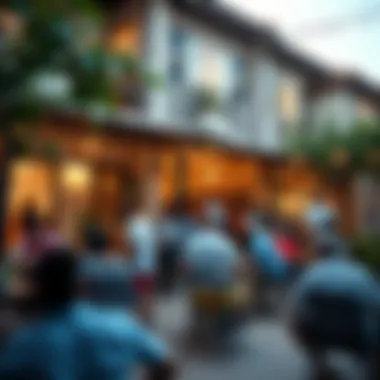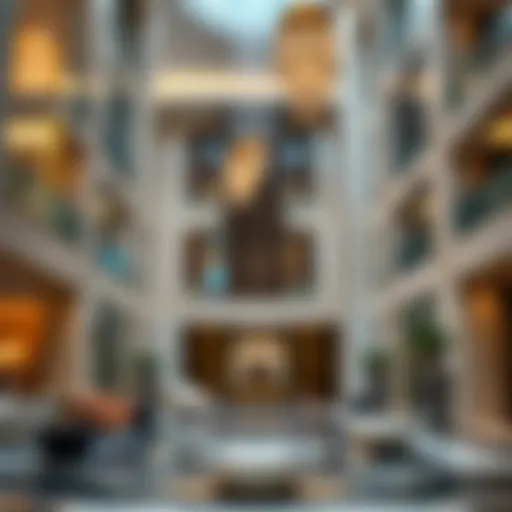Examining the Role of Society Houses in Urban Areas


Intro
The idea of society houses has emerged as a focal point in the discourse surrounding urban development, particularly in downtown areas. At their core, these establishments offer a unique blend of civic engagement and communal space, serving as cultural hubs that can catalyze interactions among diverse groups of individuals. This article aims to unravel the various layers of the society house concept, illuminating its historical backgrounds, architectural styles, and the rich interactions that take place within their walls. As urban landscapes evolve, understanding the significance of society houses becomes paramount for real estate professionals, urban planners, and community leaders alike.
Market Overview
Current Trends
Society houses are more than just bricks and mortar; they symbolize a growing trend towards community-focused spaces in urban centers. Currently, cities are witnessing a surge in projects that emphasize communal living and social connectivity. In bustling downtowns, society houses often incorporate multifunctional spaces where gatherings, events, and essential services coexist, addressing both community needs and urban lifestyle challenges.
- Collaborative Design: Many new society houses are being designed with collaboration rooms, art galleries, and co-working spaces, echoing the trends seen in shared living arrangements.
- Inclusivity and Accessibility: There is a notable push for inclusivity, ensuring these spaces are accessible to a broad demographic, including different age groups and socio-economic classes.
- Sustainable Practices: New developments are increasingly prioritizing sustainability, integrating green technologies and eco-friendly materials into their designs.
Forecast and Predictions
Looking ahead, the trajectory of society houses in urban areas seems promising. With more cities recognizing the need for recreational and social platforms, we can expect:
- An Increase in Funding: Municipal governments are likely to allocate more resources to develop these hubs, viewing them as essential for the well-being of urban populations.
- Growing Popularity: The demand for such spaces will likely rise, reflected in architectural trends that cater to communal needs.
- Enhanced Property Values: Properties in proximity to well-designed society houses might experience significant appreciation, as they become attractive for both residents and investors.
"Society houses can play a crucial role in enhancing social capital and fostering community bonds in urban environments.”
Investment Opportunities
Residential Properties
Investing in residential real estate proximal to society houses can be a robust strategy. Properties that benefit from being near these active hubs often attract buyers and renters who value community engagement.
- Mixed-Use Developments: Many new residential projects are incorporating elements of society houses, providing amenities that appeal to community-based living.
- Gentrification Dynamics: In some urban areas, the rise of society houses contributes to the overall revitalization of neighborhoods, which can lead to increased property values; thus, timing becomes critical for potential investors.
Commercial Ventures
For those looking towards commercial ventures, the landscape surrounding society houses also presents several promising avenues:
- Retail Spaces: Local businesses that align with the ethos of community—like artisanal cafes or boutique shops—often benefit from the foot traffic generated by society houses.
- Event Hosting: Commercial entities that offer services related to event planning, catering, or entertainment can find a ready market within society houses and their networks.
- Partnerships and Collaborations: Engaging with society houses can open up unique partnerships for cross-promotional opportunities.
Understanding the dynamics of society houses can transform the urban narrative from mere housing units to thriving community hubs. As we consider the future of downtown areas, the role of society houses cannot be overstated. Consider engaging with resources such as Wikipedia or Britannica for further details on the implications of community-focused architecture.
Preface to Society Houses
Society houses serve as a fascinating intersection of community, culture, and architectural design, prevalent in downtown areas. Understanding this concept is crucial because it sheds light on how these spaces foster connections, enhance urban landscapes, and create platforms for social engagement. Increasingly, urban development is incorporating these structures to revitalize communities, drawing on their historical significance while adapting to modern needs.
Definition and Conceptual Framework
At its core, a society house can be understood as a versatile gathering space intended for various societal functions. These venues may host community meetings, social events, arts exhibitions, or even educational programs. The term encompasses more than just a physical structure; it embodies the essence of community interaction and progressive city planning.
Every society house exudes its own unique atmosphere, defined by its purpose and the community it serves. For instance, a society house built in the 19th century may prioritize traditional architecture and heritage, while a contemporary version might focus on sustainability and open, flexible designs. As such, society houses are not just passive participants in urban architecture; they shape the social fabric of the environments they inhabit.
Key defining elements often include:
- Community Focus: Prioritizing the needs and culture of local residents.
- Multi-functionality: Serving various purposes, adaptable to community events and gatherings.
- Architectural Character: Aesthetic appeal, reflecting historical or modern design trends.
This conceptual framework illustrates that society houses are essential to nurturing urban neighborhoods, making them more inclusive, vibrant, and connected.
Historical Context of Society Houses
The evolution of society houses can be traced back to the need for communal spaces in urban settings. In the past, these structures were pivotal in shaping local identity. They often functioned as centers for political, cultural, and social discourse. For example, consider how societies like the Freemasons and various cultural organizations utilized these houses to conduct meetings and facilitate community bonding.
As cities grew, the role of society houses transitioned; they adapted to reflect changing societal values and aspirations. In the early 20th century, many cities experienced a surge in these establishments, marked by significant investments in community infrastructure.
In more recent history, the rise of digital connectivity has brought new challenges and opportunities for society houses. Despite the increasing trend of virtual interactions, there remains a fundamental human desire for physical connection, making these spaces more relevant than ever. Indeed, they continue to evolve, catering to modern sensibilities while preserving their historical roots.
"Society houses are the threads that weave individuals into a cohesive community."
Recognizing their historical context and ongoing relevance is key for urban planners, investors, and community leaders looking to foster a richer urban experience.
By exploring the heritage and current adaptations of society houses, one can appreciate their significance in creating lively, engaged urban landscapes.
Emerging Trends


In recent times, society houses have begun to embrace:
- Technological Integration: Using smart technology for better resource management.
- Inclusive Design: Ensuring accessibility for all community members.
- Cultural Fusion: Blending elements from multiple cultural backgrounds to reflect the diversity of urban populations.
As society houses continue to transform, their role in urban dynamics is likely to deepen, highlighting their importance in the ongoing interplay between culture and development in downtown areas.
Architectural Features of Society Houses
Architectural features are the backbone of society houses, shaping not only their aesthetics but also their functionality. These elements play a crucial role in defining the identity of these structures within urban landscapes. Society houses act as community hubs; thus, understanding their architectural makeup is essential for urban planners, architects, and investors. The design aspects influence how these spaces are perceived, used, and integrated into the downtown fabric.
Design Elements
Facade Styles
The facade of a society house serves as the first impression, acting like a cover of a book. A key characteristic of facade styles in society houses is diversity. From grand Victorian exteriors to sleek modern glass fronts, each style tells its own story. A well-designed facade captures attention, inviting curiosity from passersby. Taking into account the local architectural language, incorporating elements that relate to the neighborhood’s style can enhance attractiveness.
One unique feature of some facade styles is the use of biophilic design, integrating greenery into the exterior. This brings several advantages: for one, it improves air quality; for another, it creates a serene environment in urban settings. However, this may also require more maintenance compared to traditional facades.
Interior Architecture
Interior architecture is another essential aspect, shaping the day-to-day experiences of the users. The layout and flow of spaces within society houses focus on flexibility. A key characteristic here is openness, allowing for various configurations to host different events. This adaptability makes society houses popular for multifunctional use; however, it might come at the cost of privacy, which some users might expect for quieter gatherings.
An interesting element is how light is utilized within these structures. Natural light can significantly enhance ambiance and reduce energy costs. The unique feature of large windows and skylights can create a vibrant atmosphere, drawing people in. There are some disadvantages, though; larger openings could lead to increased heating or cooling costs in extreme weather, requiring careful energy management.
Landscaping Elements
Landscaping is often overlooked but can significantly enhance the experience of a society house. A key characteristic of effective landscaping is a seamless integration with the building’s architecture. Thoughtfully arranged green spaces can add beauty and improve mental well-being for users.
A popular choice involves using native plants, which require less water and maintenance, promoting environmental responsibility. Unique features like rain gardens can also help with stormwater management, reducing urban runoff. However, improper landscaping choices can lead to increased pest problems or the need for pesticides, mitigating some of the intended benefits.
Sustainability Considerations
As concerns about climate change grow, sustainability in the architectural features of society houses becomes increasingly significant.
Energy Efficient Technologies
Energy efficiency is at the forefront of sustainability in design. The installation of solar panels and smart energy systems are notable trends contributing to energy self-sufficiency. These technologies make society houses cheaper to run over time, appealing to budget-conscious stakeholders. One unique feature, like green roofs, improves insulation and helps with stormwater management. However, initial costs for these systems can be high, posing a barrier for some developments.
Ecological Footprints
Assessing the ecological footprint of society houses helps in understanding their impact. A lower footprint means less energy consumption and waste production, aligning with community sustainability goals. The key characteristic of sustainable site selection is its focus on previously developed land. This encourages urban density, a vital factor for sustainable communities. A unique benefit comes from incorporating energy-efficient materials, which not only limit resource depletion but can also create healthier indoor environments. However, some regions may lack availability of these materials, complicating the construction process.
Materials and Construction Practices
The choice of materials directly affects the sustainability of society houses. Using local materials can significantly reduce transportation emissions, a key benefit when planning. Sustainably sourced timber and recycled metal are examples of materials that help in achieving these aims. One notable feature is the usage of low-VOC (volatile organic compound) paints and coatings that enhance indoor air quality. While these materials often improve sustainability, they may also carry a higher price tag, which could be a deterrent for some project budgets.
Role of Society Houses in Urban Dynamics
The role of society houses in urban dynamics is monumental, serving as keystones for community interactions and economic growth in bustling downtown areas. These spaces, with their ability to attract diverse groups, provide an opportunity for various activities that enrich public life. From hosting vibrant cultural celebrations to supporting local businesses, society houses foster an environment where social cohesion thrives. This confluence of community engagement and economic vitality plays a crucial part in shaping urban landscapes, making it essential to examine how society houses contribute to these dynamics.
Community Engagement
Public Events and Gatherings
Public events and gatherings organized in society houses mark a significant aspect of community engagement. These events, ranging from farmers' markets to annual festivals, create a meeting ground for residents and visitors alike. The beauty of these gatherings lies in their inclusive nature, often drawing a varied crowd that might not interact otherwise. One might think of how a cozy space can spark conversations between strangers, leading to friendships forged over shared interests. Such accessibility caters to a broad demographic, fueling interest in community-centric activities.
However, an important consideration with public gatherings is the potential strain on local resources. In cases where many people flock to an event, it might overwhelm infrastructure, creating challenges for city planners. Yet, the popularity of these gatherings illustrates their positive impact, increasing foot traffic and commerce for nearby shops, an undeniable boon for local businesses.
Art and Cultural Exhibitions
Art and cultural exhibitions in society houses add layers of richness to urban life. These events not only showcase local talent but also serve as platforms for dialogue around art and culture, further solidifying community identity. The key characteristic of these exhibitions is their ability to educate and inspire, creating opportunities for underrepresented artists to shine. One unique feature is the integration of local themes, making art more relatable and engaging for residents.
On the flip side, organizing such exhibitions can pose challenges like funding and curating diverse collections. Yet, the advantages outweigh the drawbacks, as these events foster a sense of pride among community members and enhance the cultural fabric of the downtown area.
Educational Programs
Educational programs offered in society houses represent another significant avenue for community engagement. They can range from workshops on sustainability practices to lectures on local history, facilitating continuous learning opportunities. The key appeal here is that they offer valuable skill-building and knowledge-sharing in an informal setting, which can be especially beneficial for those who may not have access to educational institutions.
A unique feature of these programs is the collaborative aspect, often involving local experts and community members. However, a challenge is ensuring these programs remain accessible and cater to all age groups. Nevertheless, when well-executed, educational initiatives empower community members, which in turn strengthens community ties and encourages active participation.
Economic Implications
Local Business Support


Local business support emanating from society houses plays a crucial role in energizing downtown economies. These venues often collaborate with nearby businesses, providing them a platform to showcase their products or services during events. For instance, local cafes might set up stalls at a cultural festival, leading to heightened visibility and opportunities for sales.
The underlying characteristic of this support is symbiosis; as society houses thrive, so do local businesses. This mutually beneficial relationship can enhance the overall economic vitality of an area. Yet, the challenge lies in ensuring that such collaborations are sustained and nurturing, rather than one-off events.
Job Creation
Job creation is another significant economic implication associated with society houses. By organizing various events and programs, they require staffing, from event coordinators to maintenance crew. This not only contributes to lowering the unemployment rate but also helps cultivate a skilled workforce within the community. The appealing aspect of job creation in society houses is that it often reflects the local culture and needs, leading to positions that resonate with community values.
However, as beneficial as these opportunities are, it's essential to consider job stability and benefits for the employees involved. Temporary positions may arise during events, posing uncertainty for the workforce.
Property Value Effects
The presence of society houses can also have a notable impact on property values in nearby areas. When these community hubs flourish, they often make neighborhoods more desirable places to live. Increased foot traffic and enhanced neighborhood activity can lead to a rise in property interest, translating into higher real estate values. The characteristic of property value effects is that they can be significant, not overnight, but as a gradual process of urban revitalization.
However, this can also lead to potential downsides, such as gentrification, where original residents are priced out due to rising costs. Balancing the benefits of increased property values with accessibility for existing residents is a poignant challenge that many urban planners must navigate.
Society houses act as cornerstones, binding local culture, economics, and community together, sculpting the urban identity one event at a time.
Perspectives on Society Houses
The significance of examining the perspectives on society houses lies in understanding how these institutions interact with and shape their communities. Society houses are not just physical structures; they are cultural landmarks that embody the values and identities of the neighborhoods they inhabit. By exploring various viewpoints—those of local residents, urban planners, and developers—we gain insights into the broader implications of integrating society houses into downtown settings.
Local Communities
Community Identity
Community identity plays a pivotal role in the dynamics of society houses. This concept revolves around how individuals perceive themselves as part of a collective, rooted in shared experiences and values. Society houses often become the heart of this identity, symbolizing pride and continuity for residents.
The incorporation of local art and history within the design of these houses can strengthen community ties. For instance, when a society house showcases local artists, it reinforces the unique characteristics of the area. Residents tend to feel more connected and rooted, fostering a collective consciousness that enhances community identity. However, if designed without input from locals, society houses can sometimes come off as alien or disjointed from community values, creating a disconnect that hinders that sense of belonging.
Sense of Belonging
The sense of belonging is another cornerstone that society houses bring to urban locales. This concept manifests in the emotional connection individuals feel toward their community, shaping a welcoming atmosphere. When society houses host inclusive events, they cultivate spaces where people feel valued and heard.
Such gatherings can range from farmers' markets to cultural festivals, drawing diverse crowds and fostering relationships among community members. This interaction can be a boon for social cohesion, but challenges may arise if certain groups feel marginalized or excluded from these spaces. Thus, understanding the dynamics of inclusion is essential when designing programs and events for society houses.
Challenges and Opportunities
The challenges and opportunities that society houses face are often intertwined. One primary challenge is balancing heritage preservation with modern needs. As these houses must stay relevant in rapidly changing urban spaces, they sometimes struggle to meet contemporary demands while honoring their historical significance.
Opportunities arise from this struggle. By innovatively adapting spaces, society houses can become multifaceted centers that serve various community functions—cultural venues, educational hubs, or co-working spaces. The key characteristic here is flexibility. A flexible design attracts more community engagement but also demands continuous thoughtful planning and investment.
Urban Planners and Developers
Planning Considerations
On the urban planning side, understanding planning considerations is fundamental to effectively integrating society houses within the urban framework. Thoughtful site selection and design are crucial. Urban planners must consider factors like accessibility, visibility, and proximity to public transport to ensure society houses can function as vibrant community anchors.
Moreover, societal trends should inform planners. For instance, a growing preference for mixed-use developments can guide the design of nearby spaces to complement the offerings of society houses, creating seamless connections between public and private activities.
Integrating Society Houses in Urban Schemes
Integrating society houses into urban schemes can enhance the fabric of downtown areas. A cohesive design, where society houses link with commercial establishments or parks, can create dynamic spaces that attract diverse groups. \n One effective strategy is to implement zoning policies that favor mixed-use and multifaceted developments. This approach can enhance foot traffic, fortifying the economic viability of the society houses and nearby local businesses.
Case Studies of Successful Implementations
Examining case studies of successful implementations can guide future endeavors in urban planning. Cities that have integrated society houses—like Philadelphia with its community arts venues—can provide valuable lessons. These examples often showcase best practices in engaging diverse communities, leveraging local talent, and creating adaptive reuse of historical spaces.
Key takeaways often include the importance of community involvement in the planning process, ensuring that society houses reflect local identities while promoting inclusivity. Furthermore, these case studies highlight the challenges faced, such as managing funding sources and maintaining community engagement over time, while also revealing how overcoming these hurdles can lead to revitalized neighborhoods.
Challenges Facing Society Houses
Society houses play a pivotal role in shaping urban spaces, yet they aren’t without their struggles. Gaining insight into these challenges is crucial for ensuring their longevity and relevance in the community. Their existence hinges on multiple factors, from financial sustainability to cultural sensitivity, each of which poses unique obstacles. Understanding these issues can aid stakeholders, including urban planners and local governments, in crafting solutions that support these community hubs.
Financial Sustainability
Funding Sources
For society houses to thrive, they must secure adequate funding. This financial lifeblood comes from various sources, including local government grants, private donations, and business sponsorships. A key characteristic of these funding sources is their long-term fragility; reliance on a single revenue stream can quickly lead to instability. It's essential for society houses to diversify their funding strategies to buffer against economic downturns.


Many of these houses tap into community fundraising events or crowd-funding campaigns, which not only provide financial support but also help to engage the local populace. These funding sources can be beneficial; however, they may come with the burden of unmet expectations or conditional support. It's a double-edged sword, where potential benefits must be weighed against the risks of dependency.
Operational Costs
Another challenge is managing operational costs, which include maintenance, utilities, and staffing. These costs can add up quickly, draining financial resources and causing tension within the organization. A unique feature of operational costs is their unpredictability, especially when it comes to aging facilities that may require unexpected repairs. Thus, budgeting effectively is not just recommended; it is essential.
To combat rising operational costs, society houses often adopt strategies like finding energy-efficient technologies. While these practices can lead to long-term savings, they often require substantial initial investments, which can be a hurdle in itself. Balancing operational efficiency with financial constraints is a complex but necessary aspect of their management.
Cultural Sensitivity
Preserving Heritage
Cultural sensitivity is an invaluable asset for society houses located in diverse urban areas. The importance of preserving heritage cannot be overstated; it helps maintain the community's identity. A hallmark of society houses is their historical significance, which often becomes a part of their charm. However, striking a balance between honoring the past while meeting modern demands can be tricky.
Effective heritage preservation often emphasizes valuing local narratives. This can mean incorporating community stories into public programs or restoring historical elements in architecture. Yet, these preservation efforts can be costly and time-consuming, meaning that they are often sidelined in favor of more immediate or financially urgent needs.
Adapting to Modern Needs
Conversely, adapting to modern needs is just as crucial. Today’s society houses must cater to a younger, more tech-savvy audience. This transition involves more than simply adding Wi-Fi; it's about creating flexible spaces that can serve multiple purposes. This adaptability is a vital characteristic for keeping these venues relevant in an ever-evolving urban landscape.
Nevertheless, adapting to these needs can lead to clashes with traditionalists who may resist change. The challenge lies in forging a path that honors the past while innovating for the future. Addressing these cultural sensitivities effectively can be advantageous as it allows society houses to thrive as comprehensive community centers that foster inclusion and engagement without losing sight of their roots.
In today’s world, society houses must navigate the delicate interplay between funding, operational costs, and cultural considerations to secure their place in the urban fabric.
By confronting these challenges head-on, society houses not only preserve their legacy but also ensure their viability in fostering community engagement for generations to come.
Future of Society Houses
As we gaze into the horizon of urban development, the concept of society houses continues to evolve, reflecting broader societal needs and aspirations. It’s crucial to understand how this evolving future will shape the landscape of our downtown areas. By contemplating what lies ahead for society houses, we not only set a course for their architectural and social relevance but also envisage their role in fostering community ties and enhancing urban livability.
Trends in Design and Usage
Technological Innovations
The incorporation of technological innovations into society houses is not merely a trend; it stands as a beacon of progress. With advancements such as smart building systems, these houses can optimize their energy consumption remarkably. One standout feature is the use of internet of things (IoT) devices, which can monitor and manage energy use in real time. This functionality not only leads to cost savings but also encourages environmentally responsible practices among community members.
Yet, it isn't all rosy. While technology enhances functionality and sustainability, it could also introduce challenges, such as the digital divide. Not everyone in a community may have the skill set to engage with these systems, potentially creating a gap in equitable access within society houses.
Flexibility in Spaces
Flexibility in spaces is another key element shaping the future of society houses. The modern emphasis on multi-purpose areas allows society houses to adapt to varying community needs—be it hosting cultural events, fitness classes, or meetings. Such flexible arrangements enhance not just usability but also community participation.
However, the downside may lie in the potential loss of distinctiveness. When spaces are too adaptable, they might lack the unique character that draws people in. It’s a balancing act, one that requires deliberate design choices to ensure spaces remain both functional and inviting.
Potential Impacts on Urban Living
Enhanced Connectivity
In today’s fast-paced urban environments, enhanced connectivity provided by society houses goes beyond mere geography; it fosters social integration. By creating spaces that facilitate easy access to public transportation and pedestrian pathways, society houses can serve as pivotal nodes within the urban framework. This interconnectedness nurtures a sense of belonging, as individuals from various backgrounds come together in shared spaces.
Yet, there’s the frequently ignored aspect of gentrification. Increasing connectivity might drive property values up, making it challenging for long-term residents to afford their homes. Keeping a balance between revitalization and preservation is vital to the future of these structures.
Community Resilience
Community resilience is paramount for the vitality of urban life, and society houses play a critical role in this sphere. These venues can function as centers for emergency preparedness and support during crises, such as natural disasters or economic downturns. Their ability to mobilize resources and foster cooperation empowers residents to respond effectively to challenges.
Nevertheless, community resilience does not come automatically. It is a gradual process, built on trust and collaboration. Society houses must invest in local leadership and engagement strategies to cultivate this resilience over time. Creating a sense of ownership among residents is essential for nurturing a thriving and robust community.
"The future of society houses will determine not just their sustainability but also the quality of life for residents in urban centers."
Epilogue
The conclusion of this article ties together the myriad aspects discussed regarding society houses in downtown areas. These structures not only serve as architectural landmarks but are vital nodes in promoting community spirit and engagement. They encapsulate a blend of tradition and modernity, reflecting the evolving needs of urban populations.
Summary of Key Points
In reviewing the critical subjects of this article, it’s noteworthy to highlight:
- Historical Significance: Society houses have deep roots, often representing local heritage and culture.
- Architectural Diversity: Their designs range from classic to contemporary, enhancing the aesthetic appeal of urban spaces.
- Community Engagement: These houses provide a venue for public events, artistic exhibitions, and educational initiatives, nurturing local talents and fostering social ties.
- Economic Contributions: Society houses stimulate local economies by supporting businesses and creating job opportunities, which can lead to increased property values.
- Sustainability Efforts: A growing emphasis on eco-friendly practices showcases the responsibility society houses take towards the environment.
This summary unveils the multifunctional benefits that society houses offer, making them essential in the urban fabric.
Final Thoughts on Society Houses
As urban settings continue to grow and change, the role of society houses becomes increasingly crucial. They reflect the community's heartbeat, integrating history with a forward-looking vision. Engaging local residents in these spaces ensures that they remain relevant and vital.







